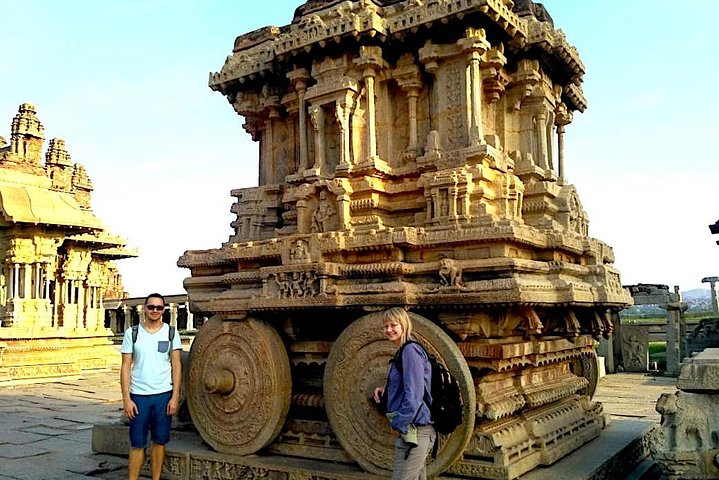Exploring the Timeless Ruins of Hampi: A Cultural Odyssey
Drawn by the allure of Hampi’s ancient ruins, I embarked on a journey to explore the Vijayanagara Empire’s rich history and culture. With all logistics handled, I was free to immerse myself in the enchanting world of Hampi, where history, mythology, and art intertwine.
A Journey Through Time: The Enchanting Ruins of Hampi
As I embarked on my journey to Hampi, the ancient capital of the Vijayanagara Empire, I was filled with anticipation. The allure of exploring a world heritage site, rich with history and culture, was irresistible. The drive from Bangalore was long, but the comfort of having all the logistics taken care of allowed me to relax and immerse myself in the experience. The landscape gradually transformed, and soon, the majestic ruins of Hampi came into view, promising a journey back to the 15th century.
Our first stop was the Ugra Narasimha, a colossal idol standing 22 feet tall. Carved by a Brahmin during the reign of Krishnadevaraya, it was a sight to behold. The intricate details, including the serpent with an open hood at the back of the head, were mesmerizing. As we moved on to the Badavi Linga, the largest of all lingas in Hampi, I was struck by its grandeur. Made of black stone and perpetually surrounded by water, it exuded a sense of timelessness.
The Balakrishna Temple, built to celebrate the conquest of Udayagiri, was next on our itinerary. The carvings of mythical beasts and the story of Lord Krishna’s infancy were captivating. As the day drew to a close, we ascended Hemakunta Hill, where ancient temples stood against the backdrop of a setting sun. The panoramic views of the town were breathtaking, and I felt a deep connection to the history that surrounded me.
The Heart of Hampi: Virupaksha Temple and Beyond
The day ended at the Virupaksha Temple, a magnificent structure from the Hoysala period. Its eleven-storey tower, rising 165 feet, was awe-inspiring. The river Tungabhadra flowing inside added to its mystique. As I wandered through the temple, I couldn’t help but reflect on the stories of the Ramayana, which I had read in preparation for this trip. The connection between the mythology and the physical space was palpable, and it enriched my understanding of the site.
The following day began at the Vijaya Vittala Temple, perhaps the grandest masterpiece of Hampi. The stone chariot, made of rough quartz, stood proudly at the entrance, adorned with figures of soldiers, hunters, and even foreign visitors. The musical pillars, a testament to the artistic genius of the time, resonated with a melody that seemed to echo through the ages.
Our journey continued to the Royal Enclosures, where the King’s Balance, a massive stone frame, stood as a reminder of the generosity of the Vijayanagara kings. The Elephant Stables, Queen’s Bath, and Lotus Mahal were equally impressive, each telling a story of a bygone era. The Zanana enclosure, once the domain of royal women, offered a glimpse into the lives of those who once inhabited this grand city.
Reflections on a Cultural Odyssey
As I reflected on my time in Hampi, I realized that this journey was more than just a tour of ancient ruins. It was an exploration of a rich cultural tapestry, woven with threads of history, mythology, and art. The knowledgeable guide, who spoke fluent English, was instrumental in bringing the stories of Hampi to life. His insights into the local culture and history added depth to the experience, making it more than just a visual feast.
The additional activities, such as the river walk and coracle boat ride, offered a different perspective of the area, allowing me to connect with the natural beauty of the region. The opportunity to purchase banana-leaf silk, a local specialty, was a delightful way to bring a piece of Hampi’s culture home with me.
Hampi is a place that leaves a lasting impression, and while 1.5 days was enough to whet my appetite, I found myself longing for more. Perhaps a longer stay would allow for a deeper exploration of this fascinating site. For those planning a visit, I recommend reading Salman Rushdie’s “Victory City” and Manu Pillai’s “Rebel Sultans” to gain a deeper understanding of the historical and cultural context. Hampi is truly a treasure trove of history and culture, and I am grateful for the opportunity to have experienced it firsthand.

















































